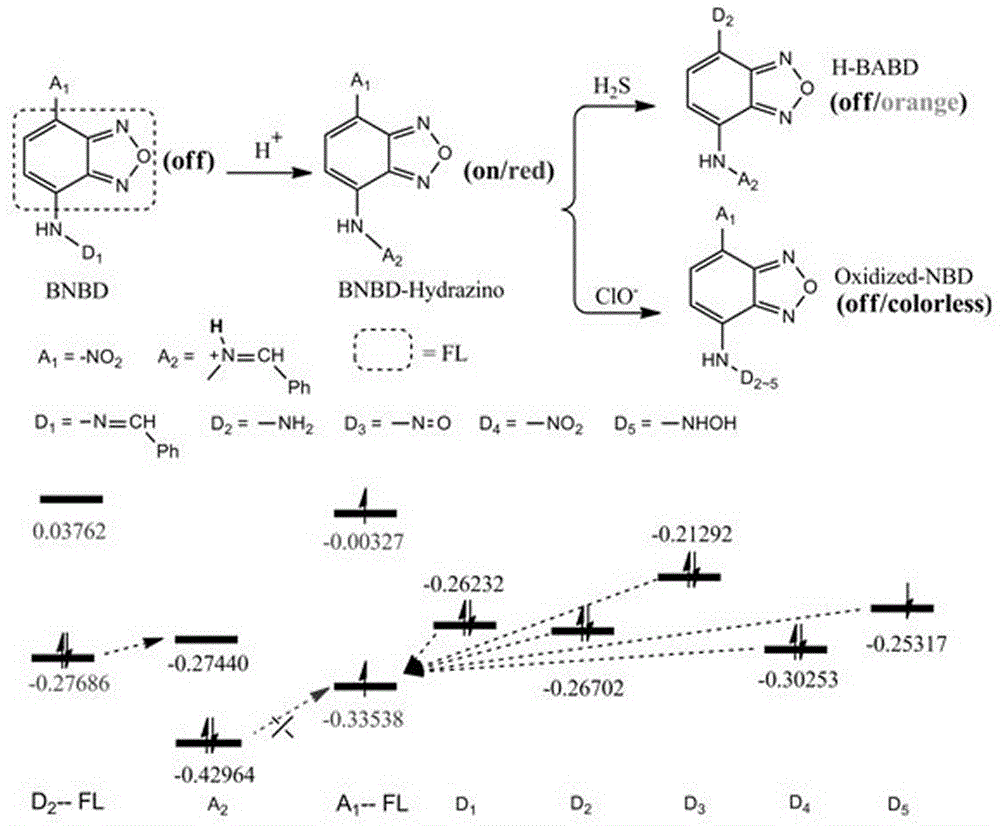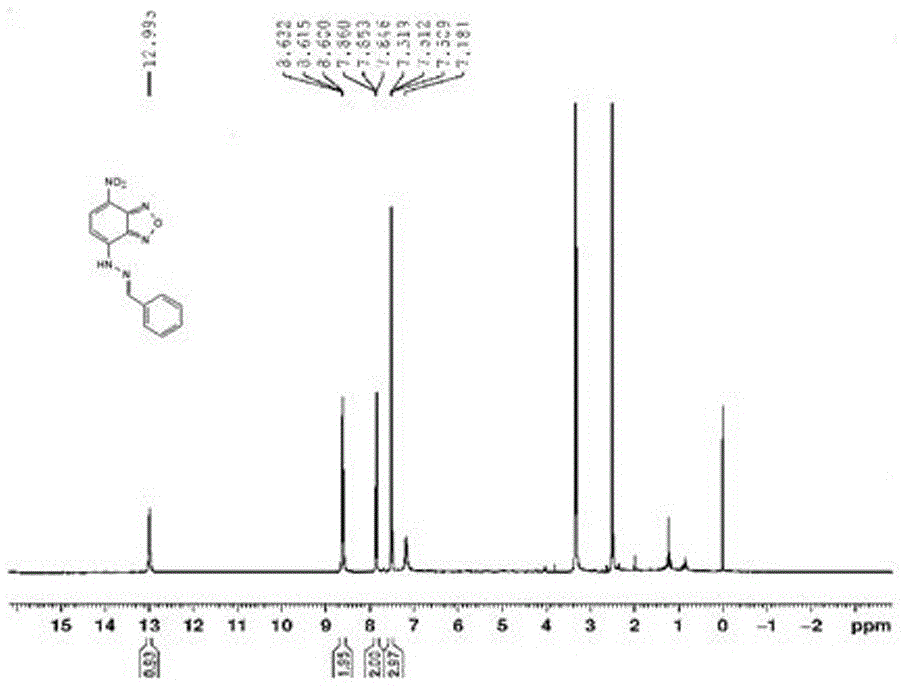Preparation method and application of dual-response fluorescent molecular probe for detecting ClO<->/H2S based on hydrogen ion activation
A fluorescent molecular probe and dual-response technology, applied in the field of analytical chemistry, can solve problems such as limitations and achieve sensitive detection
- Summary
- Abstract
- Description
- Claims
- Application Information
AI Technical Summary
Problems solved by technology
Method used
Image
Examples
Embodiment 1
[0066] Example 1: Preparation of probe BNBD
[0067] A dual-response detection of ClO based on hydrogen ion activation - / H 2 The preparation method of S fluorescent molecular probe, the steps are:
[0068] (1) Dissolve 0.3g NBD-Cl in 50mL chloroform, then add 50mL hydrazine hydrate-methanol solution with a volume concentration of 0.6%, mix well, and stir at room temperature for 30min to obtain a brown precipitate, filter, and wash the filter cake with ethyl acetate , dried to obtain 0.29g of brown product, to obtain product 1 (HNBD), and the yield was 97%;
[0069] (2) Dissolve product 1 in 20ml of ethanol with a concentration of 0.0195g / mL, add benzaldehyde at a concentration of 1mol / L, add glacial acetic acid at a concentration of 0.1mol / L, reflux for 3 hours, cool, and precipitate a red-black solid, solid Elute with ethyl acetate-petroleum ether eluent with a volume ratio of 1:1, collect the first product, and dry it to obtain a red solid, which is the dual-response det...
Embodiment 2
[0077] Embodiment 2: Detection of ClO in isolated gastric juice - and H 2 The content of S (using the dual response detection ClO based on hydrogen ion activation prepared in Example 1 - / H 2 S fluorescent molecular probes)
[0078] Three groups of rabbits were cultivated respectively. Rabbits in group 1 were fed with chlorine water; rabbits in group 2 were fed with cysteine; rabbits in group 3 were normal rabbits. After half a month of feeding, the gastric juices of the three groups of rabbits were taken for measurement and detection.
[0079] Prepare the solution
[0080] Preparation of probe BNBD stock solution: Accurately weigh ClO based on dual-response detection based on hydrogen ion activation - / H 2 S fluorescent molecular probes were dissolved in anhydrous acetonitrile and prepared at a concentration of 2×10 -4 Probe BNBD stock solution of M;
[0081] Preparation of target ClO - Stock solution: Accurately weigh the target ClO - Soluble in water, the preparat...
Embodiment 3
[0091] Example 3: Detection of sample ClO in isolated gastric mucosa - and H 2 The content of S (using the dual response detection sample ClO based on hydrogen ion activation prepared in Example 1 - / H 2 S fluorescent molecular probes)
[0092] Isolated gastric mucosa: taken from the three groups of rabbits in Example 2, the gastric mucosa was first rinsed with artificial gastric juice to scrape off the impurities outside the mucosa, then a thin layer of about 1mm was taken, soaked and cleaned with normal saline, and placed on a glass slide for use imaged under a microscope.
[0093] Preparation of artificial gastric juice: Take 16.4ml of dilute hydrochloric acid with a mass concentration of 9.5-10.5%, add 800ml of water and 10g of pepsin, shake well, add water to dilute to 1000ml.
[0094]1) Prepare the solution: the method is the same as in Example 2, the blank isolated gastric mucosa sample and anhydrous acetonitrile are mixed at a volume ratio of 5:1 to obtain a serum ...
PUM
 Login to View More
Login to View More Abstract
Description
Claims
Application Information
 Login to View More
Login to View More - R&D
- Intellectual Property
- Life Sciences
- Materials
- Tech Scout
- Unparalleled Data Quality
- Higher Quality Content
- 60% Fewer Hallucinations
Browse by: Latest US Patents, China's latest patents, Technical Efficacy Thesaurus, Application Domain, Technology Topic, Popular Technical Reports.
© 2025 PatSnap. All rights reserved.Legal|Privacy policy|Modern Slavery Act Transparency Statement|Sitemap|About US| Contact US: help@patsnap.com



